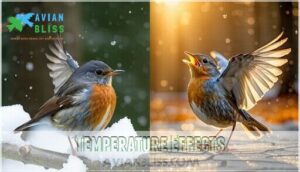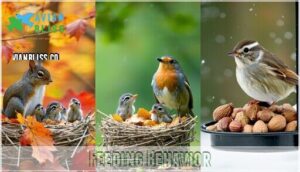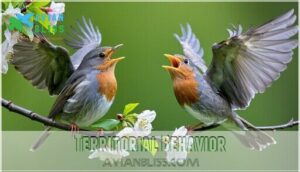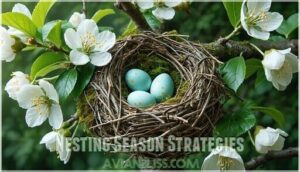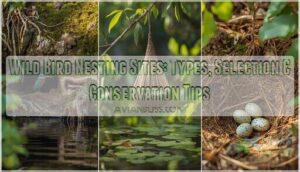This site is supported by our readers. We may earn a commission, at no cost to you, if you purchase through links.
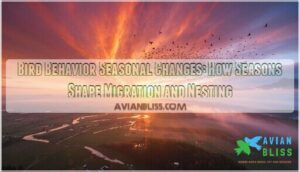
In spring, migration kicks into gear, with birds traveling thousands of miles to find mates and nesting grounds—imagine a traffic jam in the sky!
Summer’s all about raising chicks, protecting nests, and feasting on abundant food.
Come autumn, birds prepare for another epic migration, storing energy like tiny athletes.
Winter brings quieter behaviors, with many flocking together for warmth and safety.
Weather, like temperature and storms, often impacts these patterns, showing just how adaptable birds are.
Curious about how specific birds handle these changes?
There’s plenty more to uncover, with birds exhibiting epic migration patterns and a strong instinct for survival.
Table Of Contents
- Key Takeaways
- Bird Seasonal Changes
- Weather Impact Behavior
- Bird Behavioral Adaptations
- Nesting Season Strategies
- Regional Bird Variations
- Frequently Asked Questions (FAQs)
- What do birds do when seasons change?
- How does weather affect bird behavior?
- What season are birds most active?
- Can birds tell when bad weather is coming?
- How do birds adapt to different seasons?
- What is bird behavior?
- Do birds seek the same weather all year long?
- Do bird watchers know the changes in the seasons?
- How does temperature affect bird behavior?
- Why do birds change their tunes during summer?
- Conclusion
Key Takeaways
- You’ll see birds migrate in spring and fall, using energy-saving tactics and adjusting routes to survive environmental changes.
- Feeding habits shift with the seasons, like eating protein-rich insects in spring and caching seeds in fall for winter survival.
- Birds adapt to weather by fluffing feathers for warmth, altering flight paths during storms, and syncing behaviors with temperature changes.
- Seasonal breeding includes bold territorial displays in spring and complex nesting strategies to protect and raise chicks.
Bird Seasonal Changes
You’ll notice birds changing their behaviors with the seasons, from migration patterns to nesting habits, as they adapt to environmental shifts.
These changes, guided by temperature, food availability, and daylight, guarantee their survival and successful reproduction year-round.
Spring Migration Patterns
Spring bird migration, beginning mid-February and stretching into mid-June, showcases remarkable arrival timing and navigation strategies.
Birds exploit seasonal changes by fueling migration at stopovers, feasting on budding plants and insects.
First broods often start in regions with earlier springs, and unique bird migration patterns include different spring routes, ensuring survival amidst shifting environments.
Migration reveals nature’s rhythm, adapting beautifully to life’s seasonal dance, and showcases remarkable arrival timing.
Summer Breeding Season
As days lengthen, summer bird activity peaks with the bird breeding season in full swing.
Males focus on mate guarding and pair bonding, while females manage intricate bird nesting habits.
Chicks rapidly develop through juvenile hunting instincts, aided by parents.
Molting season begins, ensuring vibrant feathers for survival, and it’s a lively season of growth, protection, and energy.
Autumn Migration
Autumn bird migration is sparked by hormonal changes and migration triggers like shorter days.
Birds use fattening strategies, nearly doubling their weight for the journey. Nocturnal restlessness guarantees they fly during cooler nights.
Here’s what you’ll notice:
- Bird migration routes shift southward.
- Caching behavior increases as food is stored.
- Migratory calls grow louder.
- Massive flocks appear overhead, illustrating the massive flocks and migratory calls that characterize this phenomenon.
Wintering Grounds
After autumn’s long journeys, wintering grounds become essential refuges for birds.
Shelter selection, food availability, and predator avoidance shape winter bird behavior. They shift diets, fluff feathers for energy conservation, and form groups for social dynamics.
Preparing for winter can be easier with a functional water source.
| Adaptation | Purpose | Example Behavior | Benefit |
|---|---|---|---|
| Shelter Selection | Protection | Roosting in dense foliage | Predator avoidance |
| Food Sources | Energy sustenance | Eating seeds, berries | Food availability |
| Social Dynamics | Group safety | Mixed-species flocks | Shared vigilance |
| Energy Conservation | Survival | Feather fluffing | Retains body heat |
Weather Impact Behavior
You’ll notice how weather shapes bird behavior, from adjusting flight paths during storms to changing feeding routines in extreme heat or cold.
Birds respond to temperature shifts and sudden weather events with remarkable precision, ensuring their survival across seasons, and this ability to adapt is crucial for their well-being in various environmental conditions, making temperature a key factor.
Mastering temperature shifts with precision, birds thrive year-round, showcasing nature’s adaptability and resilience through ever-changing environmental challenges.
Temperature Effects
Birds are masters at thermoregulation, adjusting their behavior to handle shifting temperatures.
In cold weather, they fluff feathers to trap warmth, much like wearing a puffy jacket. During heat stress, they pant or spread wings to cool off.
Climate change complicates this delicate balance, driving behavioral shifts as birds follow weather patterns to survive and regulate their body temperature efficiently.
These shifts can include adapting to unseasonable freeze events, which is crucial for their survival in the face of climate change and its impact on their ability to maintain body temperature efficiently.
Weather Conditions
When storms roll in or temperatures plummet, birds adapt swiftly.
Precipitation effects like heavy rain send them seeking shelter, while wind influence makes flight tricky. Humidity impacts their comfort, too.
Climate change is altering weather patterns, adding new challenges. Here’s how birds handle environmental conditions:
- Shelter during storms
- Adjusted flight routines
- Food shifts
- Rest during extremes
- Migration timing tweaks
Birds employ these strategies to cope with the changing environmental conditions, particularly in response to climate change, and its impact on their shelter.
Adapting to Patterns
When weather shifts pause you in delight or discomfort, birds follow seasonal rhythms with remarkable adaptability.
Environmental cues like temperature or resource availability spark behavioral plasticity, helping them adjust.
These phenological shifts in bird behavior guarantee they sync with the yearly cycle, proving nature’s knack for survival strategies in every season, and whether it’s timing migration or nesting, adaptability defines bird behavior patterns.
Bird Behavioral Adaptations
You’ll notice birds change their behavior throughout the year to survive and thrive in different seasons.
From adjusting feeding habits to forming flocks for safety, each adaptation helps them tackle the challenges of their environment, which is a key factor in their ability to thrive.
Feeding Behavior
Bird feeding changes are fascinating through the seasons.
Bird feeding habits shift with the seasons, showcasing their resilience as they adapt diets to thrive in ever-changing environments.
In spring, rising insect populations fuel energy for breeding. Nesting birds switch diets, favoring protein-rich insects for healthy chick diets, while females seek calcium sources for eggs.
In fall, food caching becomes essential, and winter suet helps birds survive harsh conditions. Ground feeding behaviors are common among species like sparrows and robins.
Adaptations like bird diet changes highlight their resilience in finding diverse food sources year-round, showcasing their ability to thrive with healthy chick diets.
Territorial Behavior
In spring, territoriality kicks in as birds defend their space with bold aggression displays and sharp vocalizations.
It’s like neighborhood disputes, but feathered! These behaviors guarantee resource control and attract mates.
Seasonal bird behavior can include chasing rivals or dramatic aggression near nests.
If you’re into bird behavior observations, watching these territory defense tactics is both educational and thrilling!
Migration Patterns
Migration triggers fascinating bird journeys.
Birds use the stars, magnetic fields, and landmarks for navigation, creating migratory routes that span continents.
They rely on stopover ecology—rest and refuel sites—to survive.
Climate change disrupts these patterns, but conservation efforts help.
Here’s how seasonal bird behavior shapes migration:
- Northward spring migrations.
- Gulf-crossing flights.
- Autumn’s extended migrations.
- Daylight-activated departures.
- Wintering ground arrivals.
These patterns are influenced by various factors, including climate change, which affects the birds’ ability to navigate and find food, making stopover ecology crucial for their survival.
Flocking Behaviors
You’ve seen birds move together like synchronized swimmers, right? That’s flocking behavior. It boosts survival by improving predator avoidance and foraging benefits.
In flock dynamics, bird social behavior balances cooperation and competition. Birds use communication signals to maintain order in flocks.
Check out this table about flock behavior:
| Aspect | Example | Purpose | Key Feature | Benefit |
|---|---|---|---|---|
| Flock Size | Sparrows (small) | Safety | Tight groups | Predator avoidance |
| Social Hierarchy | Geese | Leadership roles | Pecking order | Foraging efficiency |
| Foraging Benefits | Starlings | Food location | Coordinated movement | Easy meal sharing |
| Communication | Chickadees | Warning calls | Vocal signals | Group alertness |
| Predator Avoidance | Pigeons | Group formation | Quick reactions | Lower attack risk |
Nesting Season Strategies
You’ll notice birds putting remarkable effort into choosing safe nesting spots and gathering the perfect materials to build sturdy, camouflaged homes.
Their strategies, from defending against predators to ensuring the nest suits future chicks, are carefully adapted to the challenges of the season.
Nesting Preparation
Getting ready for nesting? Watch males kick-start nest building, selecting prime spots and weaving twigs with flair. Females often tweak these designs for coziness.
Choosing the right nesting materials is essential—think feathers, moss, and maybe lichen for nest camouflage. Sourcing suitable nest supplies can greatly aid the process.
Look for these steps:
- Locate a safe nest spot.
- Gather flexible materials.
- Begin careful nest construction.
- Enhance with camouflaging decor to ensure the nest is well-hidden and secure, which is crucial for nesting success.
Bird Defense Tactics
Birds use clever defense tactics to outsmart predators. From injury feigning like killdeer to mobbing behaviors that overwhelm threats, their toolbox is impressive.
Camouflage techniques and territorial behavior help evade detection, while alarm calls warn allies. Ground-nesting birds, for example, often use elaborate distraction displays to protect their young.
Here’s a quick look:
| Tactic | Purpose | Example Species | Outcome | Fun Fact |
|---|---|---|---|---|
| Mobbing Behavior | Overwhelm predator | Songbirds | Predator retreats | Can scare off hawks! |
| Camouflage | Avoid detection | Ground-nesters | Stealth | Mimics natural surroundings. |
| Alarm Calls | Raise alert | Chickadees | Allies scatter | Like a neighborhood watch! |
| Injury Feigning | Distract predator | Killdeer | Nest spared | Feigning injury works wonders. |
| Territorial Behavior | Guard territory | Robins | Threat removed | “This turf’s mine!” |
Nesting Season Tips
Protect nesting birds by offering safe nesting materials like twigs or grass.
Place nest boxes securely, away from predators, ensuring proper ventilation. Monitor nests discreetly, avoiding disturbance during breeding.
Use predator deterrents, such as baffles, around nest boxes. Support chick development by providing calcium-rich food nearby.
Consider nest box orientation to protect from harsh weather. Remember, every little effort helps birds feel secure while building their families.
Regional Bird Variations
You’ll notice birds across different regions don’t all follow the same seasonal patterns, as their behaviors adapt to local climates and resources.
From early nesting in warm southern areas to later migrations in colder northern zones, geography plays a key role in shaping how birds respond to the changing seasons, with local climates influencing their behaviors.
Geographic Differences
Spring doesn’t unfold the same way everywhere, thanks to geographic differences.
Birds adapt brilliantly:
- Coastal Spring: Sooner warming encourages migratory behavior.
- Mountain Arrival: Delays nesting.
- Southern Breeding: Earlier egg-laying marks seasonal changes.
- Northern Nesting: Extended daylight boosts chick survival.
- Regional Diets: Insects boom near wetlands; seeds dominate arid zones.
It’s nature, conducting migration patterns like a symphony!
Local Climate Adaptations
In different areas, local birds adjust uniquely to climate.
Coastal birding highlights how warmer breezes influence migration, while mountain habitats delay spring arrivals.
Urban heat islands create Microclimate Shelters, helping species withstand temperature swings.
Regional food sources impact bird behavior, shaped by ecological research.
Desert birds exhibit seed storage behaviors for survival in challenging conditions.
Climate variability forces adaptations, revealing nature’s dynamic side as these changes highlight birds’ resilience amid ongoing climate change.
Regional Behavior Patterns
You might notice how bird behavior shifts depending on the habitat influence around them.
Migration timing changes with local adaptations, like coastal birds leaving later than inland species.
Diet variance shines, as some bird species feast on berries while others favor insects.
Species interactions also vary—some flock together for safety, while others prioritize solitude, reflecting diverse responses shaped by bird habitats.
Frequently Asked Questions (FAQs)
What do birds do when seasons change?
When seasons change, birds adapt their behavior and diet, like switching to insects in spring or seeds in winter.
They molt feathers, migrate, build nests, and even perform dances to attract mates.
How does weather affect bird behavior?
When skies turn stormy, birds act like travelers with checked luggage, adjusting flight paths to dodge danger.
They hunker down during extreme weather, fluff feathers for warmth, and time migration with favorable winds, saving energy and thriving, utilizing their ability to dodge danger.
What season are birds most active?
Birds are most active in spring when longer days and warmer weather trigger nesting, mating, and increased vocalizations.
Migration adds excitement as they return from winter grounds, turning nature into a buzzing, chirping symphony of life.
Can birds tell when bad weather is coming?
Think of birds as tiny meteorologists—they sense barometric pressure drops, hear distant storms, and spot subtle air changes.
Their behaviors, like flocking or feeding frantically, often signal impending bad weather better than your weather app!
How do birds adapt to different seasons?
You’ll notice birds shifting diets, plumage, and behaviors with the seasons.
From molting feathers for bright, attractive colors in spring to fluffing up for warmth in winter, they’re experts at survival and adaptation year-round.
What is bird behavior?
Isn’t it fascinating how birds communicate?
Their behavior includes singing, nesting, migrating, and even crafty defense tricks like feigning injury.
Each action reflects survival instincts, ensuring food, shelter, and successful reproduction amid changing environments, which is a key aspect of their behavior.
Do birds seek the same weather all year long?
Not all birds chase the same weather year-round.
Some migrate to escape harsh winters, while others adapt to their environment, braving cold with clever tricks like fluffing feathers or huddling for warmth.
Do bird watchers know the changes in the seasons?
You can often tell bird watchers know seasonal changes because they observe birds molt, migrate, or sing louder with longer days.
They track subtle shifts in bird behavior, signaling changes in weather and seasons.
How does temperature affect bird behavior?
When temperatures rise, birds become more active, forage earlier, and increase vocalizations for mating.
Cold snaps, though, slow activity, forcing them to conserve energy, fluff feathers, and seek warmer spots, like little puffy survival experts.
Why do birds change their tunes during summer?
You’ll notice birds changing their tunes in summer to protect nesting chicks.
Songs shift from attracting mates to warning rivals, defending territories, and teaching young ones survival skills—like nature’s version of a parental pep talk, which can be considered a parental guidance.
Conclusion
Did you know some birds travel over 10,000 miles during migration? Understanding bird behavior and seasonal changes reveals their incredible adaptability.
Each season brings unique challenges, shaping their feeding, nesting, and flocking behaviors. Whether it’s a robin building a nest or geese forming stunning V-formations, these seasonal shifts highlight nature’s rhythm.
Next time you spot a bird, remember—it’s likely adapting to the ever-changing seasons.


